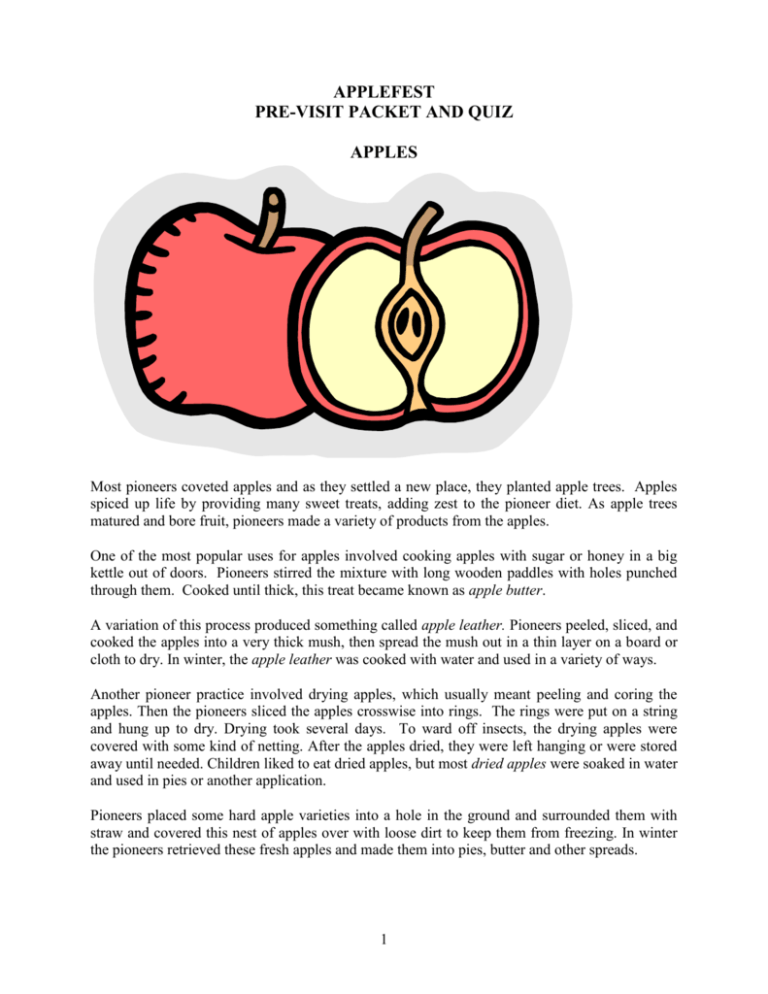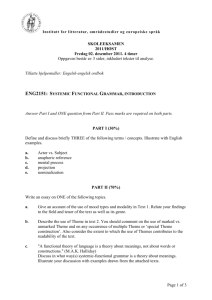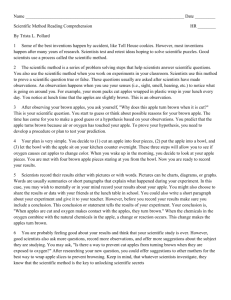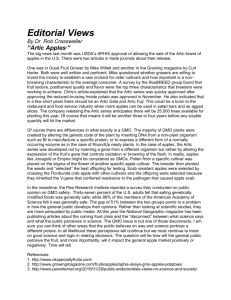APPLES - Heritage Village Museum
advertisement

APPLEFEST PRE-VISIT PACKET AND QUIZ APPLES Most pioneers coveted apples and as they settled a new place, they planted apple trees. Apples spiced up life by providing many sweet treats, adding zest to the pioneer diet. As apple trees matured and bore fruit, pioneers made a variety of products from the apples. One of the most popular uses for apples involved cooking apples with sugar or honey in a big kettle out of doors. Pioneers stirred the mixture with long wooden paddles with holes punched through them. Cooked until thick, this treat became known as apple butter. A variation of this process produced something called apple leather. Pioneers peeled, sliced, and cooked the apples into a very thick mush, then spread the mush out in a thin layer on a board or cloth to dry. In winter, the apple leather was cooked with water and used in a variety of ways. Another pioneer practice involved drying apples, which usually meant peeling and coring the apples. Then the pioneers sliced the apples crosswise into rings. The rings were put on a string and hung up to dry. Drying took several days. To ward off insects, the drying apples were covered with some kind of netting. After the apples dried, they were left hanging or were stored away until needed. Children liked to eat dried apples, but most dried apples were soaked in water and used in pies or another application. Pioneers placed some hard apple varieties into a hole in the ground and surrounded them with straw and covered this nest of apples over with loose dirt to keep them from freezing. In winter the pioneers retrieved these fresh apples and made them into pies, butter and other spreads. 1 PUMPKINS When apples were scarce, the pioneers used pumpkins to produce products similar to the ones they made from apples, including pies and spreads for bread. Pumpkin leather and pumpkin butter, made in much the same fashion as apple butter and apple leather, preserved the pumpkin for use during the winter. COOKING APPLE AND PUMPKIN PRODUCTS In order to cook dried apple or pumpkin, soak the pieces in water until they are soft. Cook them until tender in just enough water to cover them. Add as much sugar as you like. MAKING APPLE LEATHER Making apple leather involves a process that last several days. It starts with selecting the apples needed for the leather, then peeling and coring them. After slicing the peeled and cored apples into eighths, place them into a saucepan and add water so that it half covers the apples. Cook the apples until they become a thick mush. Spread the mush on a clean cloth and let it dry, usually about two to three days. PRESERVING APPLES OR PUMPKIN Dried apples can be prepared quite easily. Choose as many firm apples as you wish to dry. Take out the cores and slice the apples crosswise into rings about half an inch thick. Put the rings on strings and hand them in a sunny place until the apples are very dry. This may take several days. The apples should be brought inside each night and covered with a piece of netting as they dry. This will keep off insects. An alternative method involves slicing the apples and spreading them on a board to dry instead of cutting them into rings. MAKING APPLESAUCE AT THE VILLAGE OR AT HOME The ingredients and utensils needed include about one apple per student, sugar to taste, cinnamon, water, a pot, butter knives or table knives and a stirring spoon. Procedure: 1. Students core and peel and cut the apples into pieces. You may choose to leave the peels on and remove most of them after cooking. This will give your applesauce a red color. 2. Put the apples into the pot and cover with water. Simmer the apples until very tender. 3. Remove and mash up or blend the apples. An old-fashioned potato masher works fine. 4. Add sugar to taste. Some apples are sweeter than other to begin with so this will take a little tasting. 5. Cook gently for a few more minutes and either serve warm or after the sauce has cooled. Sprinkle a little cinnamon on top before eating. 2 OTHER APPLE FACTS Only four varieties of crab apple existed in North America when the first Europeans arrived. European settlers soon realized that America offered a superb climate for growing apples that had been cultivated in Europe. Consequently, settlers brought apple seeds from Europe and began the North American apple industry. The process of introducing a variety of European apples to North America provides a superb example of cultural diffusion. It also means that this diffusion made the expression “as American as apple pie” a reality. Pioneers recognized the usefulness of apple orchards for their farm. They provided a food product that was sweet and nutritious and that could be preserved in a number of ways to make life better during the winter. The trees also provided a windbreak for the house, the pasture, or any other part of the farm. Settlers often included seedlings along with their household goods in their westward bound wagons. These were planted as soon as possible after arrival at the new homestead. 3 AN APPLE’S LIFECYCLE 4 BUILDING A TREE ACTIVITY Instructions: Explain each part of the tree described below, having children practice acting their part. A. Tell children you will be building a tree and ask what is the first thing they will need. Seed Seed—Ask one child to become the seed and prompt them to act out how the seed gets to the ground. They should end up laying face up on the ground. B. Ask students what grows from the seed to allow the tree to grow. Roots Roots—Roots grow outward around the tree like underground branches, absorb water from the soil, and help to hold the tree upright. Select two children to act as roots, lying on their back with feet up against the seed (and eventually the tree). Ask them to make loud slurping sounds to represent water and nutrients moving from the soil to the tree trunk and branches. C. Ask students what the roots support. Tree trunk and branches Tree trunk and branches—The tree trunk and branches support the tree and move nutrients from the soil to the leaves and the fruit, which turn it into energy for the tree and seeds for new trees. Select three or four children to form a circle holding hands. They start in a squat position and then stand up, throwing their hands in the air and shouting, “Wheee.” D. Ask students what grows on the tree’s branches. Leaves and seeds Leaves and seeds—Leaves convert the nutrients and water carried to them from the roots, trunk and branches into energy for the tree by photosynthesis—a process of making energy from sunlight, water and nutrients. Seeds also grow from branches and allow for a new tree to grow after they drop to the ground or are carried to the ground inside bird or animal droppings. Select five or six children to become leaves and fruit. Have children bend at the knees and lower arms while saying, “Whooo,” to represent energy or fruit. E. Ask children what additional items their tree needs to live and have any additional children act out in their own manner rain, sun, animals, insects, etc. F. In the following order, state the commands for each part of the tree to be acted out: 1. Rain, sun, animals, insects act out you parts. 2. Roots, we need water—let’s slurp! 3. Tree trunk and branches—bring water and nutrients to the leaves and seeds— Wheee! 4. Leaves and fruit (seeds)—create energy and new seeds—Whooo! 5. End with a cheer for the actors. Use any variation of this activity, as you might deem suitable. 5 6 7 8 FUN AND FROLIC IN THE BARN Sometimes jobs such as corn husking, apple peeling, and threshing were too big for family members to finish on their own, so they held a work party, or bee, to get help from their neighbors. Bees were also called frolics. Neighbors were eager to help because they, too, would need help with work on their own farm. Since pioneer farms were far apart, people were not able to visit often with their neighbors. They welcomed the chance to tell jokes and stories while they worked. To make a big task more fun, people often made it into a contest. They worked in teams to peel apples and husk corn. Each team tried to finish their pile of corn or apples first. At apple-peeling frolics, young people tried to peel the skin from their apple in one long strip. If they did, they threw the peel into the air, hoping that it would land in the shape of a letter. It was believed that the letter would be the first initial of their future husband or wife. Apple Expressions Conduct a whole group discussion about the real meaning of these apple expressions. Then, pair the students and have them illustrate one expression. Share the pictures with the class. She’s the apple of his eye. An apple a day keeps the doctor away. One rotten apple spoils the bunch. He has a very large Adam’s apple. Jeff sure knows how to polish the apple! 9 APPLEFEST QUIZZES KINDERGARTEN Directions: Read the question or instructions to your kindergarten class. The five items are designed to acquaint the students with the Village. Use your judgment about whether they can do the tasks. 1. Your teacher will tell you about Heritage Village and allow you to color the buildings that you will visit. You will visit Hayner House, Gatch Barn, Chester Park Station, Kemper House, Kemper Kitchen, Vorhes House and Somerset Church. Please color them as your teacher instructs. 10 2. You will attend APPLE FEST at Heritage Village. Which picture shows an apple? Draw a circle around it. 3. Heritage Village has a Halloween event called Haunted Village. Lots of spooky things happen in the Haunted Village. Which of the following items could be used to decorate the Village for Halloween? Draw a circle around it. 11 4. All of Heritage Village’s buildings are old. Kemper House, a log house, is the oldest. Draw a circle around something that looks old. 12 5. Heritage Village Museum has a barn, the Gatch Barn. It was a barn used to store equipment such as plows and as a gathering place for neighbors, who would help each other with apple processing, corn husking and other farm tasks. When people help each other it is called cooperation. Which symbol below shows cooperation? Draw a circle around the best answer. 13 FIRST GRADE Directions: Please read the questions to your class and have them perform tasks as their skill level dictates. Feel free to invent new tasks, as you feel appropriate. 1. You will visit Hayner House, Gatch Barn, Chester Park Station, Kemper House, Kemper Kitchen, Vorhes House, and Somerset Church. Choose a color or colors for these buildings. Color the water blue and the trees green. 14 2. American pioneers planted many crops. Some were used to make jams and other spreads for bread as well as pies. Which picture shows something that can be made into a jam or a pie and that grows on a tree? Circle the correct answer. 3. It takes two pumpkins to get enough pumpkin filling to make a large pie. Mrs. Kemper wants to make three pies for Thanksgiving. How many pumpkins would Mrs. Kemper need? Circle the correct number Mrs. Kemper needs. ------------------------------------------------------------------------------------------------- -------------------------------------------------------------------------------------------------- 15 4. One of the buildings that you will see in Heritage Village is a church. Which building is a church? Circle the correct picture. 5. Sometimes jobs such as corn husking, apple peeling, and threshing grain were too big for family members to finish on their own, so they held a work party, or bee, to get help from their neighbors. This is called cooperation. Which picture below shows a cooperative activity? Circle the correct answer. 16 SECOND GRADE Directions: Circle the best answer or write and answer in the space provided. 1. You will visit Heritage Village for Apple Fest and stop at stations in Hayner House, Gatch Barn, Chester Park Station, Kemper House, Kemper Kitchen, Vorhes House and Somerset Church. Read the map below and circle or color each of the places you will visit. Color the water blue and write in the block below the map the direction of the gravel lane that passes by Hayner House, Elk Lick House and Chester Park Station. What direction is the gravel path? Write here: 17 2. An “apple bee” or “apple cutting” was a common entertainment among farmers in the fall. The farm families gathered together to peel and process the apples into dried apples, applesauce, apple butter, apple leather, apple cider, apple pies and other apple treats. If the farmers wanted to move baskets of apples from the orchard to the barn, which of the items below would they use? Circle the best answer. 18 3. Look at the pictures below. In 1804, when the Kemper Log House was built in Cincinnati, no mechanical—steam driven—means of getting to Ohio existed. Circle the picture that shows a mechanical or steam-driven means of transportation. 19 4. Mrs. Kemper asked five of her fifteen children to bring her two baskets of apples from a neighbors’ orchard. Circle the number of baskets Mrs. Kemper expects her children to bring. ------------------------------------------------------------------------------------------------ -------------------------------------------------------------------------------------------------- 20 5. Ohio farmers kept a variety of animals to help them plow their fields and to move things such as apples, hay, corn, and wheat to barns and towns. Circle the animal that a farmer would use for plowing and hauling things. 21 THIRD GRADE Directions: Circle the correct answer or write in the space provided. 1. Question 1 refers to the map below. Apple Fest uses Hayner House, Gatch Barn, Chester Park Station, Kemper House, Kemper Kitchen, Vorhes House, and Somerset Church. Circle the buildings that are not used in Apple Fest. 2. Using the map above, give the direction of the barn door, if the door faces the stream and Hayner House. Circle the correct answer. (a) South (b) North (c) West. 22 3. Read this excerpt from a story about “apple cutting.” Use the block after the story to write the main idea. “An apple-bee or apple cutting as it was called in the Middle West, was a common entertainment among farmers. After the summer’s work was laid by, in the lull of the year, the apple orchards were scenes of jollity and abundance. The early fall apples and what were left over from the late summer trees were gathered in heaps, … some for the cider-mill and apple butter making, and some for drying. For both of these processes, large quantities of apples, peeled, cored, and quartered, were necessary, as every family made at least a half barrel of apple-butter, or never less than one big copper kettle full. Dried apples were greatly depended upon also, as fruit canning was then not known. … Usually invitations were sent about by word of mouth a few days before the apple cutting was to come off. Tubs, baskets, large kettles, all sorts of receptacles came into use to hold the apples brought into the house for the workers. Usually the ‘married folks’ came and worked all day or afternoon. … [When] the old folks went home, [they sent] the young ones for their share of work and fun. … Then came supper, apple and pumpkin pies, cider, doughnuts, cakes, cold chicken and turkey; after which games, ‘Forfeits,’ ‘Building a Bridge,’ ‘Snatchablility,’ even ‘Blind Man’s Bluff’ and ‘Pussy Wants a Corner,’ then going home in the moonlight. All these customs I knew before I was ten years old, by having been present at an apple peeling in my own home, and one at my grandmother’s.” Write the main idea here: 23 4. One of the places you will visit in Heritage Village, Chester Park Station, was a transportation hub. Circle the picture of a 19th century form of transportation. 24 5. If an apple cutting used eight thousand, three hundred, and forty-two apples, what number would represent the apples used? Circle the correct answer. (a) 8,024 (b) 8,432 (c) 8,342. 6. If a farmer wanted to get his apples to market, what would he use to do it? Circle the correct answer. (a) A horse. (b) A buck wagon. © A stagecoach. 25 Question 7 refers to the map below. 7. If Johnny Appleseed was born in Massachusetts, moved to Western Pennsylvania, then to Ohio and then to Indiana, what general direction did Johnny Appleseed go? Circle the correct answer. (a) West to East (b) East to West (c) South to North. 26 8. Judith Kemper, the woman who first lived in the Kemper Log House, gave birth to her fifteenth child the day she moved into the house in 1804. If a few years later, Mrs. Kemper told each of her eight youngest children to bring her six buckets of water to process apples, how many buckets of water would she expect to get? Write the answer in the block below and show how you arrived at the answer using a number sentence. Write Here: 9. Many people grew apples and often it was too much for one family to harvest, dry, and make the apples into sauce or other good things. If the family had a barn with an open floor, what would be the least expensive and most effective way for it do to solve the problem of not having enough people to take care of the apples? Circle the best answer. (a) Hold an apple bee for neighbors—a get-together with food, work and fun--in the fields, house, and barn to get the apples harvested and processed. (b) Ask the neighbors to come to a dance at the barn and hope they might pick some apples. (c) Pay workers from the local town to come to the barn to pick the apples and make them into apple products. 27 10.If a farmer wanted to treat his family to meat, but did not want to kill any of his domestic animals, which animal would he hunt? Circle the correct answer. (a) (b) (c) 28







